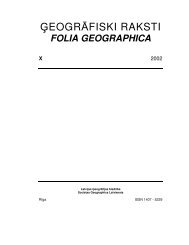eogrÄfiski raksti folia geographica xii - Ä¢eogrÄfijas un Zemes zinÄtņu ...
eogrÄfiski raksti folia geographica xii - Ä¢eogrÄfijas un Zemes zinÄtņu ...
eogrÄfiski raksti folia geographica xii - Ä¢eogrÄfijas un Zemes zinÄtņu ...
You also want an ePaper? Increase the reach of your titles
YUMPU automatically turns print PDFs into web optimized ePapers that Google loves.
39<br />
NATURE RESEARCH<br />
xA air and continental subpolar air cP would enable the existence of snow cover but would not<br />
increase its thickness, although cP air may produce light snowfall. In the 1990s the coldest cA<br />
air was identified only in the last week of December 1996. The temperature minimum over<br />
snow covered territories dropped to -30º to -36ºC. The xA air affected Latvia each January, yet<br />
it was not identified each December. The xA air brings the customary severe winter weather,<br />
when the daily average temperatures may fall to -25° or -26°C. The first half of MW<br />
(December) showed as high a frequency of continental air as the previous season (PW), but the<br />
second half was very much dominated by mP air.<br />
In mid-winter, a day or two may occur, when midlatitude (mSp, xSp) air arrives, and in<br />
January 1998 even subtropical xS air reached Latvia. These very warm air masses together with<br />
warmed subpolar air comprised together ca 30% (fronts excluded).<br />
As a whole, MW produced precipitation < 60 mm/month. In the 11-year period, MW was<br />
characterised by the lowest annual variation of the prevailing air mass frequency compared to<br />
other seasons. The standard deviation of monthly near surface air and 850 hPa pseudopotential<br />
temperatures were lower than in other winter months (Table 1, Figure 8). However, it should be<br />
noted that the present study did not include any winter with an extended inflow of cA air<br />
because 1987/1988 was the start of a period of relative mild winters. January 1987 is known to<br />
be the coldest on 100-year record. An <strong>un</strong>usually cold outbreak of cA air from the north-east<br />
brought near record low January temperatures (-37°C) and a record long period of very low<br />
(-25° to -30°C) temperatures.<br />
Late winter, LW (third decade of January to end of February)<br />
In early February the incoming short-wave radiation starts gradually increasing and<br />
doubles by the end of the month (98 MJ/m²). Regardless of the slight increase of solar radiation,<br />
February was the coldest month in five of the 11 years. Late winter is dominated by subpolar<br />
and arctic air masses. In the 11-year period the frequency of temperate/warm mP and xP air was<br />
39% and that of winter air (xA, mA, cP) 32% (fronts excluded). With an exception of the<br />
extremely warm February 1990 with only a couple of days of mA air, in late winter the<br />
frequency of arctic air masses slightly increased. Frosts are common and, although rarely, the<br />
cA air may affect Latvia. February 1994 was such a really cold month, with a minimum of –<br />
29.4°C on the coldest day in Riga and even lower (-33°C) elsewhere in Latvia as a result of cA<br />
air. Late winter shows an increased occurrence of transformed maritime air masses. The reason<br />
for this is xA air, which is more frequent at this time than in any other month because a short<br />
period of anticyclonic weather often occurs in early February. The anticyclones often form over<br />
Northern Europe in maritime air of arctic origin, which gradually is transformed into xA air and<br />
brings severe frosts in cold Februaries. The air mass t850 and θ850 are almost the same as in<br />
January ( Figures 7, 8).<br />
LW showed the lowest frequency of warmed subpolar air Ps, and also mid-latitude and<br />
subtropical air.<br />
In February of 1990, which was the warmest February on a 100-year record, when<br />
precipitation was only in the form of rainfall, the <strong>un</strong>usual warmth “woke up” the dormant plants<br />
and birch sap started rising in the last week of February. It was an extremely warm month due to<br />
several spells of mid-latitude and even subtropical air. Average diurnal temperatures stayed<br />
above zero almost the whole month except 16-19 February.<br />
LW is a dry season. In the 11-year period, the mean monthly precipitation for February<br />
was 35 to 55 mm over the territory of Latvia and 45.7 mm in Riga, comprising here 7% of<br />
yearly precipitation. Unless anomalous warm weather occurs, a continuous snow cover is<br />
common for February, which is maintained and renewed by winter air masses. On the whole,<br />
February’s average temperatures showed more variation than any other month (10.5°C), and the<br />
standard deviation of near surface air temperature and 850 hPa pseudopotential temperatures<br />
θ850 was higher than in any other month (Table 1, Figure 8).

















